Tips for florists - anthurium: transplanting and growing
The anthurium flower has an inflorescence in the form of a yellow cob, which is covered with a leaf like a blanket, the leaf is bent to the side. It originally grew in America, where there are approximately 800 species of this flower. The leaves come in a variety of colors from pale pink to bright red and green, and there are even black and white plants. There are 28 species and approximately 77 garden hybrids currently on the market. Dwarf species or young plants grow in the rooms.
Content:
Types and their features
The name of the anthurium includes 2 words: "anthos" - a flower and "oura" - a tail, which forms the word "flower tail", the plant is also called "flamingo flower". It is a slow-growing thermophilic plant that grows up to 50-70 cm.
Popular plant species:
- Anthurium Andre. This is a species from which a huge number of well-known hybrids have been derived. Naturally distributed in Colombia and Ecuador. This plant has aerial roots and a very short stem, dark green large leaves in the form of hearts, they are 20 cm wide and 40 cm long. The flower is in the form of a light cob, glistens. The plant blooms for a month.
- Anthurium Baker. Natural conditions - the tropics of South America. This is an epiphyte flower, it has long belt-shaped leaves, they reach 50 cm in length, 10 cm in width. At the bottom, the leaf has a brownish speck. The inflorescence is short - it is a white-cream ear and a light yellow-green veil along the edges turning into lilac color.
- Anthurium is majestic. Habitat - mountains and tropics of Colombia. Its spine has 4 edges and sharp edges in the form of wings. The leaves have beige-green veins, and it also has a long cover of the inflorescence.
- Crystal anthurium. Grows in Peru and Panama. Velvet leaves are decorated with contrasting veins. They are 40 cm long and 22 cm wide. The bedspread is green, turning into purple.
- Hooker's Anthurium. It grows in the Antilles. It has broad, bright green leaves with black dots. It has a long and narrow green coverlet and a purple ear.
Florists bred very beautiful anthuriums with bracts of different colors: lilac, crimson, green, burgundy, white, bright red, black, as well as various types of leaves (in the form of hearts, round, spatula).
Growing conditions
The requirement for the soil - since the roots of the flower are covered with velamen, which absorbs moisture, the soil should be light and acidic. It is necessary to make the soil from 2 parts of high-moor peat, 2 parts of leafy soil, 1 part of sand, 1 part of pine bark. For acidification, it would be good to add sphagnum to the soil.
You can also take 3 parts of peat, add 1 part of crushed sphagnum moss and 1 part of fine gravel, a little humus, and pine needles. Be sure to drain expanded clay, there must be a hole in the pot.
Quite often, pine bark 1.5 cm in size and pieces of coal from a tree are added to the soil.
They also put perlite. Vermiculite cannot be used in pots with a diameter of more than 10 cm. The neck of the plant should be wrapped in moist sphagnum to increase the moisture content.
Watering:
- In the summer, water the flower with soft water 2 times a week, the soil should be moist. Same spray it once a day, moisture should not get on the inflorescences.If water does get in, black spots will appear on the flowers.
- Water once a week in winter. If you pour it too much, the stems rot, fungus and dark spots appear on the leaves. If the air is too dry, the leaves will dry out and thin out. Therefore, at watering flower you need to observe the measure. True, overflow for a flower is more dangerous, it can lead to root rot and death. Because of this, it is necessary to drain the water from the pan after watering the plant.
- To soften the water for irrigation, add 2-3 drops of lemon juice per liter of water. But it will not work completely to make water soft in this way. It is best to freeze the water in the freezer by half, and then drain the remainder that is not frozen, unnecessary salts will remain in it.
Anthurium is a fairly shade-tolerant plant. Do not grow it on the south window. It grows best in the east and northeast window. From excessive lighting, his leaves turn yellow and curl, the petioles are shortened. It is necessary that the direct rays of the sun do not fall on it. But with insufficient lighting, anthurium will not bloom. If you make artificial lighting, then it will grow well.
Top dressing:
- Feed the plant a month before mineral fertilizer, then organic.
- If the flower grows in winter due to artificial lighting, then continue to apply in winter. fertilizers.
Thus, anthurium requires light and acidic soil, water the flower with soft water 2 times a week, feed it 2 times a month, first with organic then mineral fertilizer.
Correct transplant
Anthurium is not needed transplant often, it does not grow very quickly. As it grows, you can transfer the flower into a pot with a larger diameter, this is done up to 3 times a year. And also replace the upper 1.5-2 cm of soil 3-4 times a year. You should not transplant the plant into a pot that is too large in diameter.
The plant will not bloom until the roots have taken up the entire volume of the pot.
In addition, the soil can acidify, and this will have a bad effect on growth. At landing the flower must not be buried. If he is unstable, then you need to tie him with a string to the support.
If the trunk is bare, it is planted deeper, but the trunk is covered with sphagnum. The flower is transplanted once every 3-4 years.
Reproduction
As a rule, the overgrown anthurium is divided at transplant or you can pinch off a small branch from the mother plant. If the appendix has roots, then the cut should be sprinkled with charcoal, dried for 1-2 hours in the shade, and then it can be planted in the ground. 2 days after planting, they do not water it, they only moisten the air around the appendix. If the shoot has no roots, then it is rooted by placing it in moist sphagnum.
If an adult flower is very elongated and a bare stem has formed, then the top with 2-3 leaves is cut off and used as a cutting.
And from the old plant, a stump of 15 cm remains, after which new buds will bloom. It happens that on the bare stem and on the handle there are rudiments of roots. But even without roots, the stalk takes root well. It is put in sphagnum or in a mixture of charcoal, sphagnum, bark, then moistened. The handle is fixed, covered with a bag and placed in a bright place. The substrate is moistened. In summer, cuttings can take root even in plain water.
Sometimes it is propagated seeds:
- They take ripe fruits, remove the pulp, then put the seeds in water. The seeds quickly lose their germination, so they are planted fresh, just harvested.
- Seeds are placed on the surface of the soil from peat, leafy earth, sand, they are not buried.
- Cover with polyethylene or glass, but periodically ventilate. If the temperature is + 24-28 ° C, then in a week shoots will appear, in 1.5-2 months a real leaf will grow.
- After another 2-2.5 months, the plant is planted. Such plants bloom for 3 years.
Pinch off faded inflorescences. Also, once a week, moisten it in the shower, wipe the leaves on both sides with a wet sponge.Some people get the shine of their leaves by rubbing them with a mixture of 3 parts milk and 1 part water. That is, anthurium is propagated division or by creating a stalk from a scion.
As you can see, flower care is not very difficult. Just follow a few basic rules and it will delight you with beautiful, graceful flowers.
More information can be found in the video.



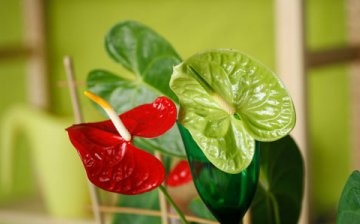
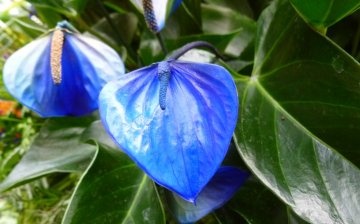
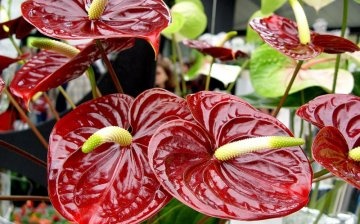
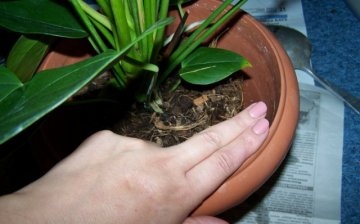
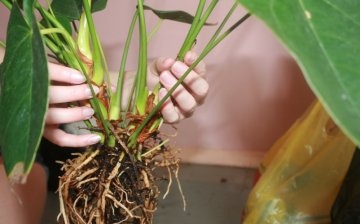






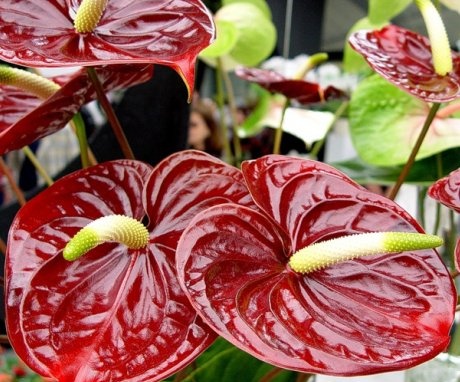
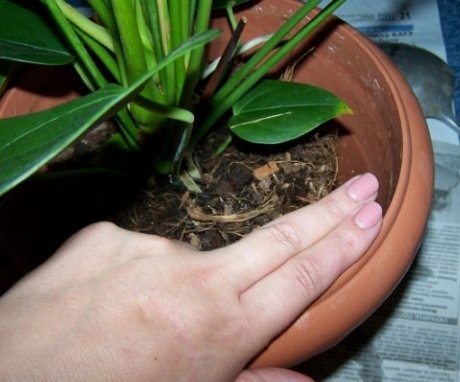

Anthurium is generally not a very picky flower. I transplant it every three years. I, for example, did not know that it is being transplanted with seeds. I usually put it in a bright place. If transplanted correctly and on time, it will always bloom.
I really like the anthurium flower. somehow I had several varieties of it, but for some reason they did not take root. After the transplant, they disappeared over time. Although before that they were healthy. And the flower is really not whimsical.